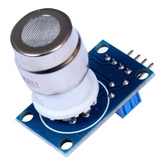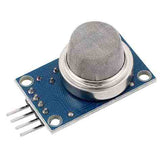What is a CO2 Sensor?
Summary
What does a CO2 sensor do? This technology has become increasingly popular in recent years for its ability to measure the amount of carbon dioxide (CO2) that is present within certain environments.
It can provide data regarding air quality, precision farming practices and improve energy efficiency. In this article, we’ll explore what CO2 sensors are, their various applications, how they work and different types available on the market today. Understanding these components will help you make an informed decision about if CO2 sensing technology
A carbon dioxide sensor is a device that is used to measure the concentration of carbon dioxide gas in the atmosphere.
It is measured using the unit “parts per million” (ppm) and typically has a presence of around 400 ppm.
Carbon Dioxide is a colourless and odourless gas. It has been identified as one of the major greenhouse gases that affect the earth’s atmosphere.
Carbon dioxide, along with methane, nitrous oxide, and fluorinated gases such as chlorofluorocarbons creates a barrier in the upper atmosphere that causes heat to be retained. This results in temperatures increasing, rising sea levels, and changes to land usage.
Carbon Dioxide is created through various means both natural and man-made, such as respiration, combustion, and organic decomposition.
How do CO2 sensors work?
Carbon dioxide is usually measured using nondispersive infrared (NDIR) or electrochemical technology. Refinements made to the NDIR-based carbon dioxide sensors have made it the most popular solution for measuring CO2 concentrations with better accuracy across extremely wide ranges up to 100% volume.
NDIR CO2 sensors monitor and detect the presence of carbon dioxide based on the rate of absorption of infrared light at a specific wavelength.
An NDIR sensor contains an infrared source, a light tube, a bandpass filter, and a detector. The target gas is chosen through the filter wavelength choice. For Carbon dioxide, the wavelength typically used is 4.26 µm.
This wavelength is not at all absorbed by other commonly found gases or by water vapor which significantly reduces cross-sensitivities and impacts moisture and humidity.
The normal operation of an NDIR CO2 sensor involves the gas being diffused or
pumped into the light tube. The electronic parts of the device then measure the absorption of the characteristic wavelength of light. The amount of light absorption is transformed into an electrical output that gives the parts per million (ppm) or % volume measurement.
To put it in simple words, more light absorbed equates to more target gas molecules present which results in a lower output signal and inversely higher reported carbon dioxide concentration.

The figure shows the working of a CO2 sensor
Why are CO2 levels important?
It was believed that carbon dioxide was harmless at common indoor levels, but new findings indicate that this is not the case. From lethargic two o’clock meetings to poor sleep, high concentrations of indoor CO2 can directly impact our health and well-being in several ways.
The major way by which indoor carbon dioxide affects our health is through our brains. As the carbon dioxide levels in a room increase, the gas starts crowding out the oxygen in the room.
Carbon dioxide is considered a simple asphyxiant because it reduces the portion of the oxygen we absorb from each breath. If indoor carbon dioxide levels get too high (around 40,000 ppm), your life may be in jeopardy.
Around 1000 ppm, a very common indoor level, you will start to experience fatigue and drowsiness and may struggle to concentrate. You may also find it uneasy to sleep, and the air will feel stuffy. With extended exposure and increases in concentration, you may develop a headache and feel physically uncomfortable.
Indoor carbon dioxide can also influence our decision-making and problem-solving skills. The Lawrence Berkeley National Laboratory uncovered a connection between carbon dioxide concentrations and our cognitive ability.
Most activities declined slightly when exposed to 1000 ppm indoor CO2 levels, but the cognitive abilities across a spectrum of functions tanked at 2500 ppm. In fact, the reduction in cognitive functioning at 2500 ppm is equivalent to the blood alcohol limit in most U.S. states.
Places that are particularly at risk of developing high indoor CO2 levels are closed bedrooms, office meeting rooms, car interiors, school classrooms, storerooms, kitchens, and home offices.
Benefits of Using a CO2 sensor
CO2 monitors offer an effective visual indication of air quality and help businesses, schools, or colleges to understand when additional ventilation is required. The key benefits of using a CO2 monitor are:
Prevent dangerously high levels of CO2 exposure
Carbon dioxide is life-threatening at extremely high levels, and even at moderate levels, it can have a detrimental impact on health. When CO2 levels reach 40,000 ppm or more, the oxygen levels are low enough that there is an immediate risk to one’s life.
Nevertheless, the risk of oxygen deprivation begins at just 5000 ppm, which could make people extremely unwell. Between 2000 and 5000 ppm, people often experience headaches, nausea, and increased heart rate.
Even at 1000 ppm, it is common for people to complain of tiredness. In occupied indoor spaces, CO2 should not be beyond 1000 ppm level to maintain good health.
Improves the performance of workers and students
Research has proven time and time again that high CO2 levels have a destructive impact on human performance.
One study from the Harvard Chan School of Public Health found that cognitive skills were reduced by 21% when CO2 levels were increased by just 400 ppm.
It was found that when CO2 concentrations were as high as 1400 ppm, the gas reduced cognitive function by 50%.
Applications
For offices, schools, and colleges who want to ensure their students thrive and businesses who want to get the best out of their employees, maintaining healthy CO2 levels is vital.
By using a CO2 monitor, it is effortless to identify when carbon dioxide levels are creeping up high enough that it might impact the performance of staff or students.
CO2 sensors are also used to monitor fermentation, respiration, photosynthesis, and other carbon dioxide-consuming or producing processes.
They can also be used for HVAC (Heating, ventilation, and air conditioning) applications to monitor air quality.
There is a wide range of applications for CO2 sensors in the agricultural, food, pharmaceutical, refrigeration, and brewing sectors.
Conclusion
CO2 sensors are an essential tool for monitoring indoor air quality and ensuring safe living environments. They work by measuring the concentration of carbon dioxide in the air. In this blog post, we have learnt that the science behind the CO2 Sensors like how do they work?, why are co2 levels important?, benefits and applications.
If you appreciate our work don't forget to share this post and leave your opinion in the comment box.
Please do check out other blog posts about Popular electronics
Make sure you check out our wide range of products and collections (we offer some exciting deals!)








